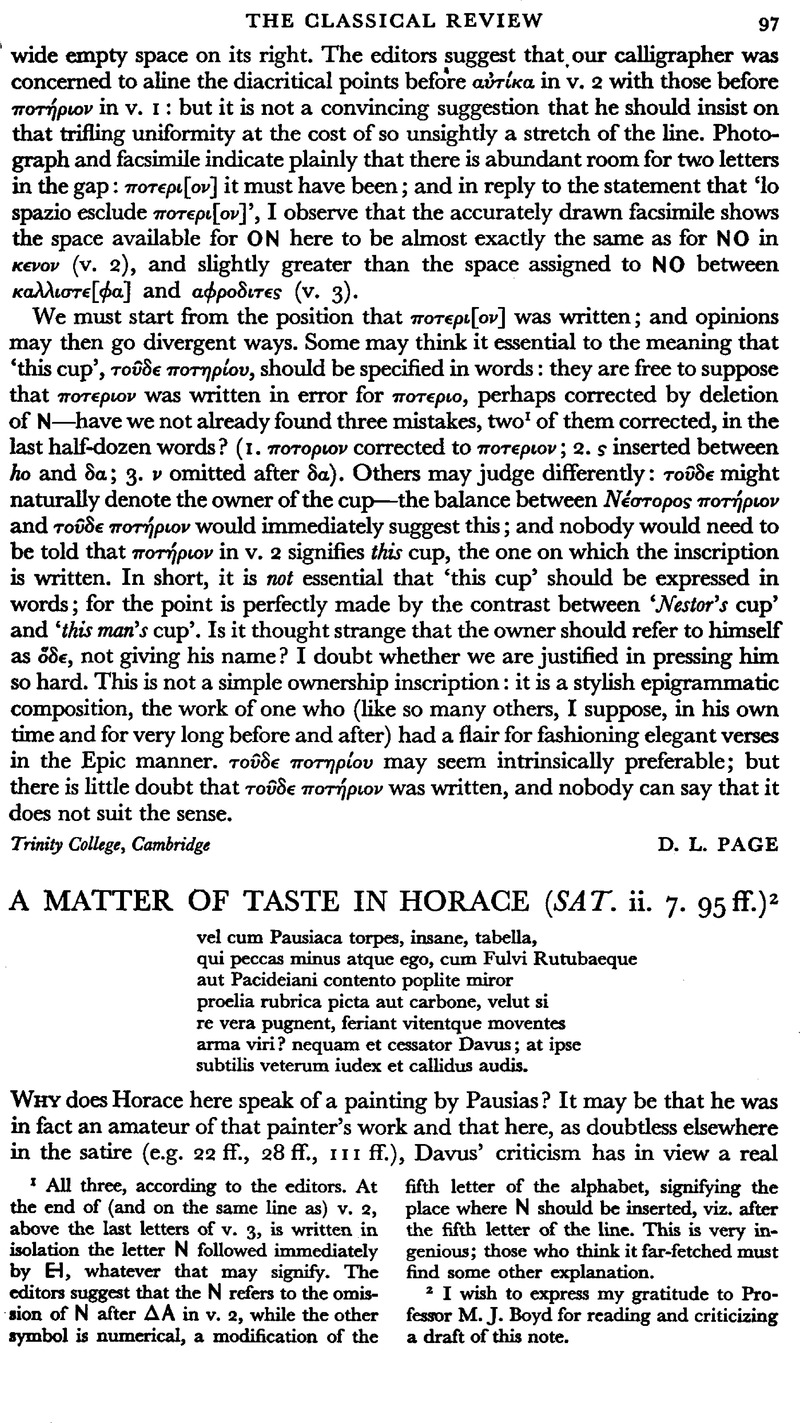No CrossRef data available.
Article contents
A Matter of Taste in Horace (Sat. ii. 7. 95ff.)
Published online by Cambridge University Press: 13 February 2009
Abstract

- Type
- Review Article
- Information
- Copyright
- Copyright © The Classical Association 1956
References
page 97 note 1 All three, according to the editors. At the end of (and on the same line as) v. 2, above the last letters of v. 3, is written in inisolation the letter N followed immediately by Ε┤, whatever that may signify. The editors suggest that the N refers to the omission of N after δA in v. 2, while the other symbol is numerical, a modification of the fifth letter of the alphabet, signifying the place where N should be inserted, viz. after the fifth letter of the line. This is very inisolation genious; those who think it far-fetched must find some other explanation.
page 97 note 2 I wish to express my gratitude to Prosion fessor M. J. Boyd for reading and criticizing a draft of this note.
page 98 note 1 Heinze's attempt to demonstrate this in his note ad loc. must be rejected since he misinterpreted part of the passage (Plin.H.N. xxxv. 127) on which his explanation rests: the concluding sentence, ‘tabulas inde e publico omnis propter aes alienum civitatis addictas Scauri aedilitas Romam transtulit’, is not concerned with the works of Pausias; it was the entire state collection of Sicyon which came to Rome.
page 98 note 2 The sources for Pausias and his work will be found in J. Overbeck, Die antiken Schrftqutllen zur Geschichte der bildenden Künste bei den Griechen (Leipzig, 1868), nos. 1760–3, to which E. Pfuhl, (Malerei u. Zeichnuing der Griechm [Munich, 1923], §800) notes that Plin. H.N. xxi. 4 should be added. For discussions see Pfuhl, § 796 ff.; G. Lippold, R.E. xviii. 2417 ff.; A. Rumpf, Handbuch der Archäologie, Lief. 6 (Munich, 1953), p. 132.
page 98 note 3 A convincing characterization of the Sicyonian ‘school’ will be found in H. Bulle, Eine Skenographie (94. Winckelmannsprogramm der deutschen archäol. Gesellschaft zu Berlin [Berlin, 1934]), pp. 23 ff.
page 98 note 4 In the boum immolatio Pausias depicted a facing ox in black and without the use of high lights in such a way that an impression of its amplitudo was conveyed (Overbeck, no. 1760 = Plin. H.N. xxxv. 126 f.; cf. O. Brendel, Röm. Mitt, xlv ‘1930’, pp. 217 ff.). In another painting Methe was shown drinking from a glass bowl with her face seen through the glass of the vessel (Overbeck, no. 1761 = Pausan. ii. 27. 3).
page 98 note 5 See Fronto, ed. van den Hout, i. 131: ‘quid si Parrhasium versicolora pingere iuberet aut Apellen unicolora … aut lascivia Euphranorem aut Pausiam t〈ristiti〉a sa〈tura〉?’
Athenaeus speaks of a painter called Pau-sanias as a πορνογράφος and gives as his source a work by Polemon on paintings in Sicyon (Overbeck, no. 1762 = Athen. xiii. 567 b). It is generally, and correctly, believed that the reference is to Pausias (see in particular Pfuhl, § 798). Lippold thinks that πορνογράφος means no more than ‘painter of hetaerae’ (R.E. xviii. 2418), but even if his view were correct, the evidence of lascivia in Fronto shows that licentiousness was a characteristic of Pausias’ work.




